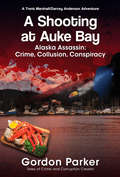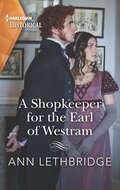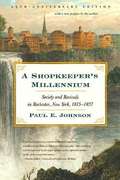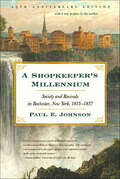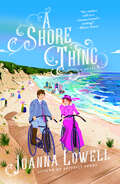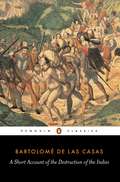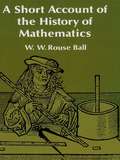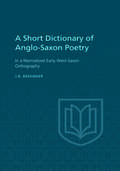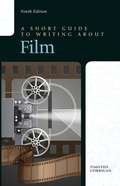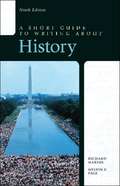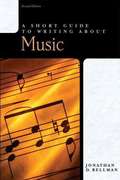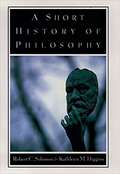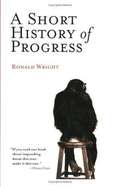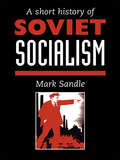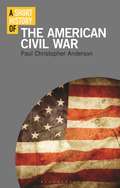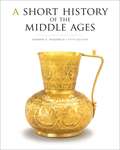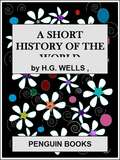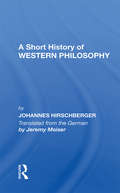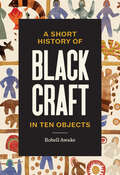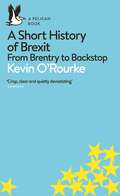- Table View
- List View
A Shooting at Auke Bay: Alaska Assassin: Crime, Collusion, Conspiracy
by Gordon ParkerDarcey Anderson stared at the lights of Juneau reflecting off the water of Gastineau Channel. She saw none of the beauty of Alaska's capital city. In her mind, she still was looking at the body of her husband, Trent Marshall, lying bleeding on the deck of the yacht. His father's friend, Robert Monk, covered Trent's body with his own, the small, semiautomatic handgun searching for a target. Captain Hannigan, skipper of the Nanuq, knelt beside the old man with his own weapon, joining Monk in seeking the shooter who had brought down their friend.
A Shopkeeper for the Earl of Westram (The Widows of Westram)
by Ann LethbridgeA pretty shopkeeper finds passion with a nobleman—but is she doomed to lose him to a proper lady?When the Earl of Westram accuses antiques seller Harriet Godfrey of peddling fakes, she accepts his grudging offer to help bring her supplier to justice. But spending time with Westram sparks an irresistible attraction . . .As an earl, he’s destined for a suitable society match, and she never wants to give up her independence. So perhaps this is the last chance for both of them to experience true passion . . . ?
A Shopkeeper's Millennium
by Paul E. JohnsonA quarter-century after its first publication, A Shopkeeper's Millenniumremains a landmark work--brilliant both as a new interpretation of the intimate connections among politics, economy, and religion during the Second Great Awakening, and as a surprising portrait of a rapidly growing frontier city. The religious revival that transformed America in the 1820s, making it the most militantly Protestant nation on earth and spawning reform movements dedicated to temperance and to the abolition of slavery, had an especially powerful effect in Rochester, New York. Paul E. Johnson explores the reasons for the revival's spectacular success there, suggesting important links between its moral accounting and the city's new industrial world. In a new preface, he reassesses his evidence and his conclusions in this major work.
A Shopkeeper's Millennium: Society and Revivals in Rochester, New York, 1815–1837
by Paul E. JohnsonA quarter-century after its first publication, A Shopkeeper's Millennium remains a landmark work--brilliant both as a new interpretation of the intimate connections among politics, economy, and religion during the Second Great Awakening, and as a surprising portrait of a rapidly growing frontier city. The religious revival that transformed America in the 1820s, making it the most militantly Protestant nation on earth and spawning reform movements dedicated to temperance and to the abolition of slavery, had an especially powerful effect in Rochester, New York. Paul E. Johnson explores the reasons for the revival's spectacular success there, suggesting important links between its moral accounting and the city's new industrial world. In a new preface, he reassesses his evidence and his conclusions in this major work.
A Shoppers’ Paradise: How the Ladies of Chicago Claimed Power and Pleasure in the New Downtown
by Emily RemusPopular culture assumes that women are born to shop and that cities invite their trade. But downtowns were not always welcoming to women. Emily Remus turns to Chicago at the turn of the last century to chronicle an unheralded revolution in women’s rights that took place not at the ballot box but in the streets and stores of the business district.
A Shore Thing
by Joanna LowellA delightfully queer Victorian love story, featuring a boldly brash trans hero, the beguiling botanist who captures his heart, and a buoyant bicycle race by the British seaside — from the author of The Duke Undone.Former painter and unreformed rake Kit Griffith is forging a new life in Cornwall, choosing freedom over an identity that didn't fit. He knew that leaving his Sisterhood of women artists might mean forfeiting artistic community forever. He didn&’t realize he would lose his ability to paint altogether. Luckily, he has other talents. Why not devote himself to selling bicycles and trysting with the holidaymakers?Enter Muriel Pendrake, the feisty New-York-bound botanist who has come to St. Ives to commission Kit for illustrations of British seaweeds. Kit shouldn&’t accept Muriel&’s offer, but he must enlist her help to prove to an all-male cycling club that women can ride as well as men. And she won't agree unless he gives her what she wants. Maybe that's exactly the challenge he needs.As Kit and Muriel spend their days cycling together, their desire begins to burn with the heat of the summer sun. But are they pedaling toward something impossible? The past is bound to catch up to them, and at the season&’s end, their paths will diverge. With only their hearts as guides, Kit and Muriel must decide if they&’re willing to race into the unknown for the adventure of a lifetime.
A Short Account of the Destruction of the Indies
by Bartolome Las CasasBartolomé de Las Casas was the first and fiercest critic of Spanish colonialism in the New World. An early traveller to the Americas who sailed on one of Columbus's voyages, Las Casas was so horrified by the wholesale massacre he witnessed that he dedicated his life to protecting the Indian community. He wrote A Short Account of the Destruction of the Indies in 1542, a shocking catalogue of mass slaughter, torture and slavery, which showed that the evangelizing vision of Columbus had descended under later conquistadors into genocide. Dedicated to Philip II to alert the Castilian Crown to these atrocities and demand that the Indians be entitled to the basic rights of humankind, this passionate work of documentary vividness outraged Europe and contributed to the idea of the Spanish 'Black Legend' that would last for centuries.
A Short Account of the Destruction of the Indies
by Bartolomé de las Casas"A Short Account of the Destruction of the Indies," published in 1552 by the Spanish Dominican priest Bartolomé de las Casas, lays bare the Spanish cruelties in America. Though generally condemned as slander in Spain, "A Short Account of the Destruction of the Indies" rapidly became popular in the rest of Europe, where it served to fuel anti-Spanish hate. Spain's enemies used it to depict Spaniards as evil tyrants and to rationalize carving out their own empires in the Americas. New editions of "A Short Account of the Destruction of the Indies" appeared repeatedly, even as late as 1898, during the Spanish-American War. While much of what Bartolomé de las Casas said is undoubtedly true, not all historians take "A Short Account of the Destruction of the Indies" as the gospel truth. Though sometimes exaggerated, Las Casas' account sheds valuable light on the "Spanish Black Legend." Bartolomé de las Casas, who was struck by the inhumane ways in which the native peoples were treated by the European explorers and conquerors, went on to be a leading opponent of slavery, torture, and genocide of the Native Americans by the Spanish colonists. "A Short Account of the Destruction of the Indies" includes chapters covering Spanish treatment of Native Americans in Cuba, Nicaragua, Hispaniola, Guatemala, Venezuela, Florida, and many other areas conquered by the Spaniards. Though short (as the name implies), "A Short Account of the Destruction of the Indies" reveals a dark but important episode in the history of Spain and America. Translated by Nigel Griffin, and with an introduction by Anthony Pagden.
A Short Account of the History of Mathematics (Dover Books on Mathematics)
by W. W. BallThis is a new printing, the first inexpensive one, of one of the most honored histories of mathematics of all time. When the last revised edition appeared in 1908, it was hailed by mathematicians and laymen alike, and it remains one of the clearest, most authoritative, and most accurate works in the field. Mathematicians welcomed it as a lucid overview of the development of mathematics down through the centuries. Laymen welcomed it as a work which gave them an opportunity to understand the development of one of the most recondite and difficult of all intellectual endeavors, and the individual contributions of its great men.In this standard work, Dr. Ball treats hundreds of figures and schools that have been instrumental in the development of mathematics from the Egyptians and Phoenicians to such giants of the 19th century as Grassman, Hermite, Galois, Lie, Riemann, and many others who established modern mathematics as we know it today. This semi-biographical approach gives you a real sense of mathematics as a living science, but where Dr. Ball has found that the biographical approach is not sufficient or suited to presenting a mathematical discovery or development, he does not hesitate to depart from his major scheme and treat the mathematics in detail by itself. Thus, while the book is virtually a pocket encyclopedia of the major figures of mathematics and their discoveries, it is also one of the best possible sources for material on such topics as the problems faced by Greek mathematicians, the contributions of the Arab mathematicians, the development of mathematical symbolism, and the invention of the calculus.While some background in mathematics is desirable to follow the reference in some of the later sections, most of the book can be read without any more preparation than high school algebra. As a history of mathematics to browse through, or as a convenient reference work, it has never been excelled.
A Short Dictionary of Anglo-Saxon Poetry
by J. B. BessingerThe author has attempted to cover the vocabulary of the whole corpus of Anglo-Saxon verse and make the word-list as broadly useful as possible for the general student of Anglo-Saxon literature.
A Short Guide To Writing About Film
by Timothy CorriganThis best-selling text is a succinct guide to thinking critically and writing precisely about film. Both an introduction to film study and a practical writing guide, this brief text introduces students to major film theories as well as film terminology, enabling them to write more thoughtfully and critically. With numerous student and professional examples, this engaging and practical guide progresses from taking notes and writing first drafts to creating polished essays and comprehensive research projects. Moving from movie reviews to theoretical and critical essays, the text demonstrates how an analysis of a film can become more subtle and rigorous as part of a compositional process.
A Short Guide to Writing about History (9th Edition)
by Richard A. Marius Melvin E. PageA Short Guide to Writing about History is an ideal complement for any history course intended to teach students to think and write like historians. This engaging and practical text will teach students how to go beyond reporting the basic dates and facts of their history books and show them how to infuse their writing with their own ideas and unique perspective. Covering brief essays and the documented resource paper, the text explores the writing and researching processes, different modes of historical writing (including argument), and offers guidelines for improving style as well as documenting sources.
A Short Guide to Writing about Music
by Jonathan D. BellmanWritten in a clear and conversational style, A Short Guide to Writing About Music examines a wide range of writing assignments for music courses at all levels of the undergraduate curriculum. Employing a variety of writing samples as a means to illustrate effective writing, this brief and inexpensive text teaches writers how to deftly research and write about music.
A Short Guide to the Pronunciation of New Testament Greek (Eerdmans Language Resources)
by Benjamin KantorWhat did the apostles&’ Greek sound like?How should New Testament Greek be pronounced in our classrooms? Often students are taught Erasmian pronunciation, which does not even reproduce Erasmus&’s own pronunciation faithfully, let alone that of the New Testament authors. But if we want to process the language of the New Testament the same way its original authors and readers did, we should use their pronunciation. In his new book, Benjamin Kantor breaks a path toward an authentic pronunciation of Koine Greek at the time of the New Testament, seeking to improve students&’ reading proficiency.A Short Guide to the Pronunciation of New Testament Greek distills Kantor&’s new monograph, The Pronunciation of New Testament Greek, with an eye toward practical instruction. The first comprehensive phonological and orthographic study of Judeo-Palestinian Koine Greek, The Pronunciation of New Testament Greek surveys thousands of inscriptions and papyri to determine historical pronunciation. A Short Guide gives students an overview of the basics of phonology before explaining the pronunciation of each Greek letter and phoneme individually. Perfect for classroom use, this guide explains Kantor&’s cutting-edge research accessibly and includes sample texts for reading practice.
A Short History Of Philosophy
by Robert C. Solomon Kathleen M. HigginsPhilosophy is a singularly expansive enterprise, a fascinating outgrowth of a human nature that demands we question who and why we are. In A Short History of Philosophy , the most accessible concise portrait of philosophy in seventy years, Robert Solomon and Kathleen Higgins meet the challenge of accurately and engagingly describing it all, revelling in philosophy as "the art of wonder," the search for meaning, a gripping, dramatic endeavor. Here is the entire history of philosophy--ancient, medieval, and modern, from cultures both East and West--described in its historical and cultural context. "The concepts that lie at the heart of philosophy antedate history by thousands of years," the authors write in their introduction, noting that the ancient concept of immortality, prehistorical ideas about magic, and the complex set of beliefs implied by the practice of human sacrifice all exhibit philosophic underpinnings. Solomon and Higgins chart the profound development of philosophical thought around the world and through the centuries from the first stirrings of speculation and wonder to the rise of distinct (and often antithetical) philosophical traditions, moral constructs, and religious practices. From the early Greek and Asian philosophers and the mythological traditions that preceded them, to the great Greek, Indic, and Chinese philosophers, to the drama of the great religious philosophies, the authors have spun a marvelous tale that leads to the development and decline of modernity. Along with the major characters, such as Aristotle, Kant, and Confucius, Solomon and Higgins draw engaging portraits of less well-known alchemists, mystics, rebels, eccentrics of all sorts, including figures often ignored in philosophy--figures such as Teresa of Avila, who contributed to the mystical traditions of Catholicism; al-Razi, a contrarian Persian philosopher within the Arabic tradition who described the philosophical life as "godlike;" and Erasmus, the Dutch philosopher who parodied the foolishness of man in his praise of folly. With a clear, witty style and a flair for making complex ideas accessible, the authors also convincingly demonstrate the relevance of philosophy to our times, emphasizing the legacy of the revolutions wrought by science, industry, colonialism, and sectarian warfare, and the philosophical responses to the traumas of the twentieth century (including two world wars and the Holocaust): existentialism, positivism, postmodernism, feminism, and multiculturalism among them. But Solomon and Higgins go beyond merely retelling the rich history of philosophy; the authors provide their own twists and interpretations of events, resulting in a story that reveals the continuing complexity and diversity of a richly textured and nuanced intellectual tradition. All who are "lovers of wisdom" will find much to reward them in this book.
A Short History Of Progress
by Ronald WrightEach time history repeats itself, the cost goes up. The twentieth century-a time of unprecedented progress-has produced a tremendous strain on the very elements that comprise life itself: This raises the key question of the twenty-first century: How much longer can this go on? With wit and erudition, Ronald Wright lays out a-convincing case that history has always provided an answer, whether we care to notice or not. From Neanderthal man to the Sumerians to the Roman Empire, A Short History of Progress dissects the cyclical nature of humanity's development and demise, the 10,000-year old experiment that we've unleashed but have yet to control. It is Wright's contention that only by understanding and ultimately breaking from the patterns of progress and disaster that humanity has repeated around the world since the Stone Age can we avoid the onset of a new Dark Age. Wright illustrates how various cultures throughout history have literally manufactured their own end by producing an overabundance of innovation and stripping bare the very elements that allowed them to initially advance. Wright's book is brilliant; a fascinating rumination on the hubris at the heart of human development and the pitfalls we still may have time to avoid.
A Short History Of Soviet Socialism
by Mark SandleMark Sandle is Lecturer in Russian and East European History at De Montfort University.; This book is intended for undergraduate courses on 20th century Soviet history/the Cold War/European history/Soviet studies/History of political thought/Marxism-Leninism. The Left.
A Short History Of The American Civil War (Short Histories)
by Paul Christopher AndersonThe American Civil War (1861-65) remains a searing event in the collective consciousness of the United States. It was one of the bloodiest conflicts in modern history, claiming the lives of at least 600,000 soldiers and an unknown number of civilians and slaves. The Civil War was also one of the world's first truly industrial conflicts, involving railroads, the telegraph, steamships and mass-manufactured weaponry. The eventual victory of the Union over the Confederacy rang the death-knell for American slavery, and set the USA on the path to becoming a truly world power. <p><p> Paul Christopher Anderson shows how and why the conflict remains the nation's defining moment, arguing that it was above all a struggle for power and political supremacy but was also a struggle for the idea of America. Melding social, cultural and military history, the author explores iconic battles like Shiloh, Chickamauga, Antietam and Gettysburg, as well as the bitterly contesting forces underlying them and the myth-making that came to define them in aftermath. He shows that while both sides began the war in order to preserve - the integrity of the American state in the case of the Union, the integrity of a culture, a value system, and as slave society in the case of the Confederacy - it allowed the American South to define a regional identity that has survived into modern times.
A Short History Of The Middle Ages
by Barbara H. RosenweinIn this newest edition of her bestselling book, Barbara H. Rosenwein integrates the history of European, Byzantine, and Islamic medieval cultures--as well as their Eurasian connections--in a dynamic narrative. The text has been significantly updated to reflect growing interest in the Islamic world and Mediterranean region. Stunning plates featuring art and architecture weave together events, mentalities, and aesthetics. <P><P> Medievalist Riccardo Cristiani authors a new feature on material culture that examines the intricacies of manuscript production and the lustrous glazes of Islamic ceramics. A fully revised map program offers user-friendly spot maps that clarify events right where they are discussed as well as dazzling topographical maps that reveal the very contours of the medieval world. Helpful genealogies, figures, architectural plans, and lists of key dates complement the text. All maps, genealogies, and figures are available on the History Matters website (www.utphistorymatters.com) for easy download. Students will find this site equally useful for its hundreds of study questions and their click-to-reveal answers.
A Short History Of The United States, 6th ed.
by Allan Nevins Henry Steele CommagerA broad overview of American history up to the resignation of President Nixon is presented especially for the general reader.
A Short History Of The World: Large Print (Barnes And Noble Digital Library)
by H. G. WellsThis Short History of the World is meant to be read straightforwardly almost as a novel is read. It gives in the most general way an account of our present knowledge of history, shorn of elaborations and complications. From it the reader should be able to get that general view of history which is so necessary a framework for the study of a particular period or the history of a particular country. It may be found useful as a preparatory excursion before the reading of the author’s much fuller and more explicit Outline of History is undertaken. But its especial end is to meet the needs of the busy general reader, too driven to study the maps and time charts of that Outline in detail, who wishes to refresh and repair his faded or fragmentary conceptions of the great adventure of mankind. It is not an abstract or condensation of that former work. Within its aim the Outline admits of no further condensation. This is a much more generalized History, planned and written afresh.
A Short History Western Philosophy
by Johannes HirschbergerA study of the historical development of philosophy both requires and stimulates intellectual detachment. The person who limits himself to the present can easily fall a prey to passing fashions; he becomes a slave of the latest -ism. Intellectually rootless and inexperienced, he succombs to something that may exercise considerable attraction at this particular moment, but that soon withers and passes. For example, Ernst Haeckel's theories once exercised an enormous fascination on all sorts of people; they were even hailed as the definitive word in philosophy. Nowadays they are more likely to cause amusement than anything else. The same may be said of Nietzsche's philosophy, or materialism, or vitalism, or idealism.
A Short History of African Philosophy (Second Edition)
by Barry HallenA Short History of African Philosophy discusses major ideas, figures, and schools of thought in philosophy in the African context. While drawing out critical issues in the formation of African philosophy, Barry Hallen focuses on recent scholarship and relevant debates that have made African philosophy critical to understanding the rich and complex cultural heritage of the continent. This revised edition expands the historical perspective, takes account of recent discoveries and new canonical figures, highlights new discussions about gender as a cultural and philosophical phenomenon, clarifies issues regarding indigenous cultures and human rights, and builds on the notion that African philosophy shares methods and concerns of philosophy worldwide. This short reference is an essential resource for students, scholars, and general readers.
A Short History of Black Craft in Ten Objects
by Robell AwakeTen beautifully illustrated essays tell the stories of handcrafted objects and their makers, providing inspiration and insight into Black history and craftsmanship.Black artisans have long been central to American art and design, creating innovative and highly desired work against immense odds. Atlanta-based chairmaker and scholar Robell Awake explores the stories behind ten cornerstones of Black craft, including:The celebrated wooden chairs of Richard Poynor, an enslaved craftsman who began a dynasty of Tennessee chairmakers.The elegant wrought-iron gates of Philip Simmons, seen to this day throughout Charleston, South Carolina, whose work features motifs from the Low Country.The inventive assemblage art and yard shows of Joe Minter, James Hampton, Bessie Harvey, and others, who draw on African spiritual traditions to create large-scale improvisational art installations.From the enslaved potters of Old Edgefield, South Carolina, to Ann Lowe, the couture dressmaker who made Jacqueline Kennedy's wedding dress, to Gullah Geechee sweetgrass basket makers, to the celebrated quilters of Gee's Bend, A Short History of Black Craft in Ten Objects illuminates the work of generations of Black craftspeople, foregrounding their enduring contributions to American craft.BLACK CRAFT AND AMERICANA: Delving into the history of Black skilled artisans, estimated to have outnumbered white artisans five to one in the southern United States in the late 1800s, this unique art history book celebrates handcrafted objects that reflect the dynamic nature of Black culture.DYNAMIC ILLUSTRATED ESSAYS: Luminous color illustrations by artist Johnalynn Holland highlight beloved craft objects and their makers, creating a fascinating volume to study and treasure.ART HISTORY EXPERTISE: Author Robell Awake is a notable furniture maker, artisan, and educator whose work has been featured in the New York Times and in group shows at Verso Gallery in New York City and the Center for Craft in Asheville, NC. Dr. Tiffany Momon, who contributes an afterword, is the founder and co-director of the Black Craftspeople Digital Archive and a leading scholar of Black history and African American placemaking throughout the southeast.BEAUTIFUL GIFT BOOK: The gorgeous design is ideal for art collectors and craft enthusiasts, as a keepsake reminder of Black heritage, for Black History Month and beyond.Perfect for:Anyone interested in the intersection of Black art, craft, and historyDesigners and craftspeopleEducators and studentsCollectors and museum curatorsLovers of fine and artisanal design objects
A Short History of Brexit: From Brentry to Backstop (Pelican Books)
by Kevin O'RourkeA succinct, expert guide to how we got to BrexitAfter all the debates, manoeuvrings, recriminations and exaltations, Brexit is upon us. But, as Kevin O'Rourke writes, Brexit did not emerge out of nowhere: it is the culmination of events that have been under way for decades and have historical roots stretching back well beyond that. Brexit has a history.O'Rourke, one of the leading economic historians of his generation, explains not only how British attitudes to Europe have evolved, but also how the EU's history explains why it operates as it does today - and how that history has shaped the ways in which it has responded to Brexit. Why are the economics, the politics and the history so tightly woven together? Crucially, he also explains why the question of the Irish border is not just one of customs and trade, but for the EU goes to the heart of what it is about. The way in which British, Irish and European histories continue to interact with each other will shape the future of Brexit - and of the continent.Calm and lucid, A Short History of Brexit rises above the usual fray of discussions to provide fresh perspectives and understanding of the most momentous political and economic change in Britain and the EU for decades.
